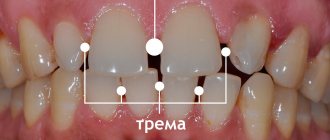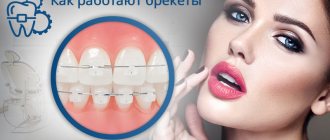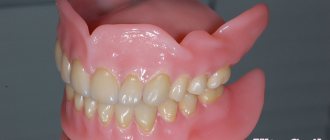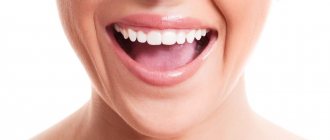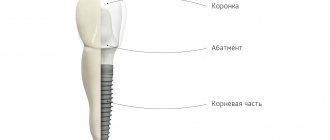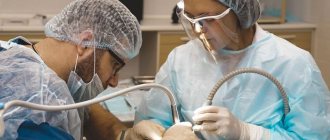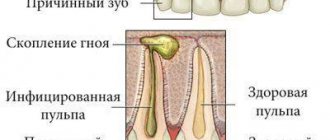Author of the article: Kryukov Andrey Vladimirovich
Chief physician. Doctor-expert
Specialization: Dentist-orthopedist
Total work experience: since 2005
Reading time: 7-8 minutes
Orthopedics in dentistry is a branch of medicine that deals with the restoration of teeth using all modern prosthetic techniques. It is not surprising that an orthopedic dentist is popularly known as a prosthetist. To preserve decaying teeth or restore the attractiveness of your smile, it is important to know with what symptoms you need to go to this specialist, what methods he uses and what results he guarantees.
Problems solved by orthopedic dentistry
To understand who an orthopedic dentist is, you need to know more about the field of medicine in which this doctor works. The main tasks that orthopedic dentistry solves are:
- restoration of dentition;
- elimination of chewing function disorders;
- installation of prostheses, as well as regulating and replacement devices;
- diagnosis, prevention and treatment of speech apparatus deficiencies;
- therapy of jaw diseases using specialized devices and structures.
The efforts of specialists working in this field are aimed at eliminating most defects in the dentition and achieving maximum aesthetics of the result (taking into account the functional component).
Contraindications
Unfortunately, not all patients can correct defects in the dental system with braces. There are a number of contraindications for wearing them. If any are present, they will definitely be identified during diagnosis.
To eliminate some negatively influencing factors, it is enough to carry out procedures or a course of treatment before the upcoming installation of braces.
The influencing factors that can be eliminated include the following diseases:
- early stage periodontitis;
- non-advanced periodontal disease;
- caries or its consequences.
A temporary allergic reaction to some materials included in the structure may also occur. This happens with individual intolerance to any substances. The problem is eliminated by replacing the irritant with another, hypoallergenic component.
However, there are diseases in which the installation of braces is strictly prohibited. Among them:
- oncological diseases;
- tuberculosis;
- HIV or AIDS;
- osteoporosis or other bone tissue pathologies;
- disorders of the cardiovascular, endocrine or circulatory system;
- severe forms of periodontal disease and periodontitis;
- mental disorders.
If the patient’s medical history contains an absolute contraindication for the installation of braces, but the dentition or bite requires immediate treatment, a solution can be found. At “People's Dentistry”, the orthodontist considers all possible options and selects the optimal method of correction.
Symptoms for which people consult an orthopedic dentist
Consultation with a specialist is necessary if the following symptoms are present:
- absence of any number of teeth in a row (as a result of planned removal, loss, after injury, etc.);
- partial or almost complete destruction of the enamel and walls of the tooth;
- diagnosed diseases of the gums or jaw bones;
- increased (and in some cases painful) tooth sensitivity;
- various types of TMJ disease (temporomandibular joint);
- cosmetic defects (in particular, irregular shape, pigmentation and other disorders that spoil the aesthetics of the smile).
A dental therapist or other highly specialized specialist can diagnose problems that should be addressed specifically by an orthopedic dentist after an initial examination and consultation.
What does an orthopedic dentist treat?
What a prosthetist does cannot be 100% called treatment in the usual sense of the word. Rather, it resolves issues that are not amenable to therapeutic treatment. For example, you may be referred to an orthopedic dentist if you need:
- Restoration of chewing function.
Gaps in the dentition do not allow chewing food with the necessary thoroughness, which has a detrimental effect on the functioning of the digestive system. The absence of one or more teeth in a row can lead to the appearance of chewing dysfunction, which disrupts the functioning of the dental system as a whole. In addition, muscle tone decreases and blood circulation slows down not only in soft tissues, but also in bone tissues. Ignoring the problem will inevitably lead to complications, in particular to periodontitis or periodontal disease. Thus, solving the issue of restoring the integrity of the dentition will help not only restore chewing functions, but also improve overall health. - Preservation of teeth
. If a tooth is not lost, but is significantly damaged, this is not yet a reason to remove it (even if the possibility of installing a filling is excluded to solve the problem). Thanks to the achievements of modern dentistry, doctors have the opportunity to preserve healthy roots and nerve endings, stop advanced caries and restore/restore the tooth. - Treatment of adentia
. Only an orthopedic dentist can help patients with partial or complete absence of teeth. In this case, based on the individual characteristics of the patient and the tasks assigned to him, the specialist will propose and install removable, conditionally removable or fixed dentures, implants or other techniques that can restore the integrity of the dentition.
The solution to the problem on the listed points is individual for each individual patient. Only a consultation and initial examination will allow us to predict and approve the treatment plan and all the nuances.
Most often, an orthopedic dentist is consulted for:
- restoration of bone tissue and enamel in order to preserve living natural roots and nerve canals;
- installing protective crowns on a tooth that is not subject to aesthetic restoration;
- individual production and installation of various types of prostheses;
- elimination of purely aesthetic defects (chips, uneven teeth, correction of enamel color, etc.).
It is mistakenly believed that the services of a prosthetist are required mainly by older patients. Modern dentistry is ready to offer effective solutions in the field of restoration and prosthetics for people of all ages, including children who have dental problems.
In-depth diagnostics
The patient received all the necessary preliminary recommendations and prognoses and decided to undergo treatment at the clinic. Then he underwent in-depth diagnostics and consulted with a psychologist, osteopath, and dentist.
The diagnosis made by the orthodontist after an in-depth diagnosis: displacement of the upper cosmetic center to the right, narrowed upper dentition, shortened lower dentition, secondary adentia of the 13th tooth, incorrect rotation of teeth 22, 35, 45, direct incisal occlusion, displacement of teeth in the lateral sections.
Consultations with a psychologist and an osteopath are needed to treat bruxism: the osteopath corrects muscle tension and tension that occurs in the bones of the skull; The psychologist helps relieve psycho-emotional stress, teaches the patient the practices of effective relaxation and self-regulation.
Before fixing the braces, the anterior teeth were restored using the direct method to improve aesthetics, as well as to maintain their health during long-term orthodontic treatment. During orthodontic treatment, hygiene is not always perfect, and therefore it is necessary to treat and seal all potential caries sites. For the same purpose, before installing braces, professional hygienic teeth cleaning is performed.
Techniques used by an orthopedic dentist
Already knowing what an orthopedic dentist treats, it’s time to understand what techniques he uses to achieve his goals. Today there are three of them:
- Microprosthetics
. Suitable for cases where the patient has only cosmetic defects and there is a high degree of preservation of the tooth (only the upper part is damaged). To implement microprosthetics, the following are used:- Veneers
. Designed to adjust the appearance of the tooth in color and shape. Ideally mask enamel defects and slight curvature. They are thin plates that are attached to the front of the teeth using special glue. The average service life is about 10 years. - Lumineers
. The design and method of use/installation are similar to veneers, but thinner. Their installation does not require preliminary grinding of all tooth enamel. - Tabs
. Unlike veneers and lumineers, they are used not on the front teeth, but on the chewing teeth. They are visually similar to fillings, but are made not from composite materials, but from ceramics. - Removable prosthetics
. Orthopedic structures for this type of prosthetics are a nylon or plastic base with securely attached artificial teeth. There are two types of such prostheses:- full
(over the entire jaw with complete edentia); - partial
(similar to “bridges”, but they can be removed from the mouth independently). - Fixed prosthetics (permanent)
. This type of prosthetics involves the use of:- Coronok
. Acts as an alternative to filling and artistic restoration. Used in cases of significant tooth decay. They are cap-shaped structures that completely or partially cover the tooth being prosthetized. They are made of metal, metal-ceramics, plastic and a combination of metal and plastic. - Bridge prostheses
. They are used in cases where several teeth in a row are missing in a row. They are structures consisting of two supporting crowns (placed on supporting units) and a “bridge” with artificial teeth located between them. - Implants.
A completely artificial structure, part of which is implanted into the bone tissue of the jaw (over time, complete engraftment/fusion occurs). They consist of artificial roots on which an artificial tooth is placed (screwed).
Such prostheses are attached using clasps (semicircular locks), suction cups, or glue (depending on the type of prosthesis).
Now you know what an orthopedic dentist treats and what modern techniques he uses for this. Don’t aggravate existing dental problems - plan to schedule a consultation with a prosthetist soon to learn more about how exactly your individual issues can be solved.
Comments
At 30 years old, does it make sense to get braces or do I need to undergo another course of treatment? If realistically, then approximately how long will they need to be worn and how effective is this method of treatment for an adult?
Victor (08/14/2018 at 11:36 am) Reply to comment
- Victor, bite problems can and should be solved at any age. As for choosing an orthodontic system that will help most effectively in your case, only an orthodontist can give advice based on examination, diagnosis and condition of the teeth and the entire dental system. And not at the first consultation, but after taking all the necessary parameters. In case of significant pathologies, braces will be one of the best solutions that can correct the situation within 1.5-2 years. It is also important that the braces will be fixed on two jaws at once (as a rule, first on one, and after a few months on the other) in order to even out the bite as a whole. But this depends, again, on the pathology. In any case, consult a doctor, your bite can be corrected!
Editorial staff of the UltraSmile.ru portal (09.17.2018 at 13:22) Reply to comment
Now it’s clear how an orthodontist differs from an orthopedist. I was constantly confused. Tell me, is there data on the effectiveness of various brace systems? I want to install lingual ones, but I’m not sure that they are better than traditional ones.
Olga (08/14/2018 at 12:01 pm) Reply to comment
- Hello Olga! Metal braces give the fastest results; ceramic and sapphire braces last longer. Self-ligating systems also solve the problem very quickly, and they do not require such frequent visits to the orthodontist. As for lingual systems, they are, of course, better than traditional ones in terms of aesthetics - they are completely invisible. But screenings are not for everyone - they can only be performed for certain malocclusion pathologies.
Editorial staff of the UltraSmile.ru portal (09.17.2018 at 14:56) Reply to comment
My adult son, 27 years old, is missing two sixth teeth. The dairy ones fell out, but the permanent ones did not grow. X-rays do not show the presence of new tooth buds. What to do now and where to find an orthodontist who has already solved a similar problem?
Olga (08/14/2018 at 12:08 pm) Reply to comment
- Dear Olga! In general, each tooth has a specific place in the jaw, so displacing some in place of others is a fundamentally incorrect position, because they have a different shape, are designed for a different load, and have different antagonist teeth. Therefore, it is still better to contact not an orthodontist, but an orthopedist who will perform dental implantation or install bridges. This will be a better decision.
Editorial staff of the UltraSmile.ru portal (09.17.2018 at 15:00) Reply to comment
We have encountered an orthodontist more than once, since many relatives in our family have an anomaly associated with teeth - the fangs grow second row, above the teeth. Daughters and nieces about 15 years ago, this problem was “successfully” resolved by surgeons. They just took and removed healthy teeth so that the fangs would fall into place. This is already the second grandson walking around with briquettes. But I'm afraid they turned up too late. Tell me, should we have consulted a specialist before these molars appeared or is it still fixable? The child is 14 years old.
Julia (08/14/2018 at 12:44 pm) Reply to comment
- Hello Julia! This phenomenon is usually called “crowding” and it can indeed be predetermined by heredity. You have already started treatment with braces, so it is more likely to help you. Removing fangs is not an option; aesthetics will be compromised. With this pathology, the distant chewing teeth are most often removed, which makes it possible to free up space for the front teeth. Although everything is individual. And yes, you should have contacted an orthodontist much earlier - you could have started treatment at the age of 6-7 years to correct the situation at the initial stage.
Editorial staff of the UltraSmile.ru portal (09.17.2018 at 15:04) Reply to comment
Unfortunately, when we were growing up, and this is the Soviet “happy childhood”, such specialists were extremely rare, so I live with an incorrect bite, and hence the conclusions, by the age of 45, oral problems have become not only acute, we now have to solve these issues. The orthodontist, as my grandchildren say, is tooth fairies and volebniks, corrected everyone’s malocclusion.
Anna Pavlovna (08/14/2018 at 12:48 pm) Reply to comment
- Dear Anna Pavlovna! Even at your age, it is not too late to solve the problem of malocclusion. There are cases where people were treated with braces at 50 and even 60 years old. The main thing is that there would be living teeth that need to be straightened! Of course, the older the person, the more work will be required - after correcting malocclusion pathologies, it will be necessary to work on the restoration of the teeth, that is, restore their shape. Throughout life, teeth wear down and their chewing surfaces change—this becomes especially noticeable after orthodontic treatment. That is why you will need to visit a therapist and replace the fillings, perhaps even put crowns and core inlays on some teeth. First, visit your doctor! Consultations in many clinics today are completely free and do not obligate you to anything.
Editorial staff of the UltraSmile.ru portal (09.17.2018 at 15:51) Reply to comment
Please tell me at what age can a brace system be installed? My daughter’s teeth are growing crooked and need to be corrected. Different clinics call different ages. Who to listen to?
Alina (08/16/2018 at 14:50) Reply to comment
- Hello, Alina! It is best to begin treatment with braces when the final replacement of baby teeth with permanent ones has occurred. For most children this happens by the age of 13, for some a little earlier - at 10-12. Previously, you could use other means of correction - for example, plates. Note that in some cases, before installing braces, you need to wear certain devices - for example, the same plates. In particular, in order to change the shape of the upper or lower jaws. So it is likely that you can start orthodontic treatment now, before the bite is completely changed and braces are installed.
Editorial staff of the UltraSmile.ru portal (09.17.2018 at 15:55) Reply to comment
As a child, I wore a plate to correct an overbite. But either the plate was chosen incorrectly, or I wore it irregularly, but the bite did not improve. Is it possible to correct a bite as an adult?
Maxim (08/16/2018 at 15:26) Reply to comment
- Good afternoon, Maxim! The bite can and should be corrected at any age. Adults are most often prescribed non-removable orthodontic devices for such purposes, namely braces. The plates are optimal for children under 11 years of age and really require a high level of control and responsibility, if not from the children themselves, then from their parents, because are removable.
Editorial staff of the UltraSmile.ru portal (09.17.2018 at 15:56) Reply to comment
After reading the article, it became easier to see how many ways there are to correct your bite and have a beautiful smile. My son is only a year and a couple of months old, but I have already begun to think about visiting an orthodontist. The baby has a fairly large gap between the upper units. Should I see a doctor now or is it better to wait until all the teeth have erupted? And is there a chance that after all the teeth appear, the gap will shrink?
Anna (08/16/2018 at 15:42) Reply to comment
- Dear Anna! For your peace of mind, you need to show your baby to a pediatric orthodontist. The situation you describe can be compared to a phenomenon called “false diastema.” It can go away when the child reaches two or three years of age when the primary bite is finally formed, or after it is replaced with a permanent one - after all, the permanent teeth themselves are larger in size. Typically, the change from primary to permanent dentition begins at 6-8 years of age, but in any case, observation and control of the situation by a specialist today will not hurt.
Editorial office of the UltraSmile.ru portal (09.17.2018 at 16:00) Reply to comment
I would like to ask if I have heard that frequent teeth whitening can be harmful to tooth enamel. How often should this procedure be done so that the tooth enamel remains strong, but at the same time has the appearance of Hollywood actors?
Vladimir (08/16/2018 at 16:40) Reply to comment
- Vladimir, teeth whitening, if you do it in a dental setting, using professional products, is a safe procedure. It can be repeated every 1-3 years, depending on how long the result lasts. It must be maintained at home - with the help of hygiene and the same professional products that the dentist will individually select for you.
Editorial staff of the UltraSmile.ru portal (09.18.2018 at 14:49) Reply to comment
Please tell me, is it possible for the front teeth to wear off with an incorrect bite? What should I do if my front incisors are half worn away? Is it possible to build up teeth and straighten my bite?
Vladimir (08/16/2018 at 16:45) Reply to comment
- Vladimir, with an incorrect bite, the teeth actually receive a completely uneven load, so tissue abrasion is a normal consequence of such a pathology. You can grow teeth, but first you need to eliminate the cause, namely, malocclusion. Therefore, visit an orthodontist first, start undergoing treatment, and then consult a therapist to restore the aesthetics and shape of your teeth. Otherwise, the treatment will not give the expected result - the teeth will continue to wear out. It is likely that you will also need to get mouthguards for bruxism if you have a similar pathology to protect your teeth from overload.
Editorial staff of the UltraSmile.ru portal (09.18.2018 at 14:46) Reply to comment
Until recently, I had no idea that there were such specialists in dental correction. I'm wondering how the braces system is installed so that it doesn't scratch the enamel of the teeth? In addition, this system still needs to be regulated somehow.
Anatoly Stepanovich (08/30/2018 at 14:49) Reply to comment
- Anatoly Stepanovich, indeed, the profession of orthodontist is very complex, because you need not only to know how the entire jaw system functions, but also to understand how to correct the bite of a particular patient, so as not to harm, but to improve the situation (after all, we are not only talking about crooked teeth, but and incorrectly positioned jaws). As for braces. Their plates actually do not come into contact with the enamel, because they are held on by a special glue (dental adhesive or even composite). The metal arc also does not touch the enamel. Yes, the system needs to be adjusted regularly: ligature braces once a month, self-ligating braces - every 2 months.
Editor of the portal UltraSmile.ru (09.12.2018 at 08:59) Reply to comment
Very useful article. I'm going to see an orthodontist. I was interested in the aligner correction system. I wonder how a system consisting of elastic material can correct the bite? She can't transmit effort.
Anfisa (08/30/2018 at 14:57) Reply to comment
- Anfisa, thank you for your question and for your gratitude to our editors. The material is relatively elastic, and the aligners fit incredibly tightly onto all teeth, so they exert a certain amount of pressure. Small, but still pressure. In addition, each aligner should be worn for about a couple of weeks, during which time the teeth will move slightly. And so on, step by step, gradually, but the bite will change. This entire process is initially thought out on a computer, followed by a thorough diagnosis, study of the condition of teeth and bone tissue, which allows you to design the process from start to finish WITHOUT errors.
Editor of the portal UltraSmile.ru (09.12.2018 at 08:57) Reply to comment
They recommend that I get braces for correction and they say that I will need to wear them for a year. It turns out that a metal structure will be in your mouth for a whole year. The metal will oxidize and oxidation products will enter the stomach and digestive tract. Isn't it harmful?
Nina (08/30/2018 at 15:04) Reply to comment
- Dear Nina! Modern brace systems are created from very high-quality materials that do not oxidize or corrode, especially those created from more expensive metals, such as titanium. Budget analogues mainly use medical steel. You should not choose metal braces if you have an individual intolerance, allergic reactions may occur.
Editor of the portal UltraSmile.ru (09.12.2018 at 08:55) Reply to comment
Write your comment Cancel reply
Which colleagues does the prosthetist interact with?
The implementation of any of the techniques used by an orthopedic dentist is impossible without close interaction with other specialists. An integrated approach to restoration and prosthetics is carried out with the contribution of the following doctors to the common cause:
- Dentist-therapist
. Performs preparatory work prior to prosthetics - carries out sanitation of the oral cavity, removes dental deposits (plaque and tartar), and treats diseases of the mucous membrane and periodontium. - Dentist-surgeon
. At the preparation stage, it removes teeth and non-viable roots in cases where the problem cannot be treated therapeutically. At the stage of prosthetics, implants are implanted into the jaw, on which the orthopedist later carries out the final stage of restoration of the dentition. - Dental Technician
. This specialist uses impressions made by an orthopedist to make the necessary prosthetics and orthopedic structures. If necessary, after fitting the patient, he also adjusts the created prostheses, correcting possible shortcomings that cause discomfort to the patient. - Anesthesiologist (or resuscitator)
. Interaction with this colleague is necessary when, with complete edentia, it is necessary to place many implants on both jaws. This procedure may require general rather than local anesthesia. - Dentist-orthodontist
. If prosthetics are to be installed, and the patient has problems with the bite, then the treatment plan includes the need to contact this particular specialist. After complete treatment, you can begin preparing and installing prostheses.
When planning prosthetics, be prepared for the fact that a comprehensive solution to the problem will be required. This means that in addition to the orthopedic dentist, you will have to visit a number of highly specialized specialists.
How is the diagnosis performed at the initial appointment with an orthopedic dentist?
Modern dentistry allows almost all manipulations to be performed painlessly for the patient. At the same time, some people who have had bad experiences in the past are afraid of visiting clinics. Most often, they prefer to know in advance what a specialist will do in order to mentally prepare not only for the procedures, but also for the initial examination, during which the diagnosis is made. If you are planning to visit a prosthetist for the first time, be prepared for the following stages of interaction:
- Basic: Questioning to collect anamnesis
. Here the specialist asks questions that will help you individually choose a method for solving the problem. - Facial examination
. To study the size of the mouth gap, possible shortening of the lower part of the face and asymmetry, features of the setting of the lips and chin. The tone of the lip muscles is also determined by palpation. - Oral examination
. The bite, shape, size and condition of existing teeth are carefully examined. The condition of the mucous membrane, the individual nuances of the formation of the frenulum of the lips are also assessed, the shape and span of the tongue, the arch of the hard palate and the general development of the jaws are studied. - X-ray
. Radiography allows you to assess the condition of the supporting units, as well as identify the presence of impacted and other special elements that cannot be detected without photographs.
(may be needed for a deeper study and accurate diagnosis):
- functional chewing samples are taken;
Based on the results of the main and additional examination, the specialist makes a diagnosis and develops individual treatment tactics. Knowing who an orthopedic dentist is, in what cases you should contact him and what he will do when you arrive at your appointment, visiting dentistry will not be so scary. And since the initial examination is absolutely painless and without discomfort, it makes sense to at least sign up for a consultation in order to understand the condition of your teeth and whether it is possible to save those about which you have complaints.
Life with braces on teeth: adaptation and care
The secret to the effectiveness of braces is the gradual movement of teeth at the level of the root system. The units move from the pathological position to the correct one, but this transition is associated with slight discomfort for the patient.
The sensations are especially unpleasant in the first days after activation: the teeth ache and even hurt. This is an adaptation period, and it lasts differently for children. Usually a week or two. Then the teeth get used to micro-movements, and the child stops feeling the braces in the mouth.
But the question of care remains open. The orthodontic design consists of many elements - with an abundance of niches, corners, and difficult-to-clean areas. Therefore, you have to devote a lot of time to caring for braces every day - 15-25 minutes twice a day. During the care process, teeth and system elements are cleaned one by one:
- orthodontic brush with V-shaped bristles;
- mono-beam brush;
- pipe cleaners;
- dental floss.
It is good to additionally use special toothpastes for patients with braces, an irrigator and a mouth rinse.
If everything is done correctly and according to the prescribed algorithms, then treatment with braces will not leave any unpleasant memories, and your teeth will acquire a straight and beautiful appearance.

